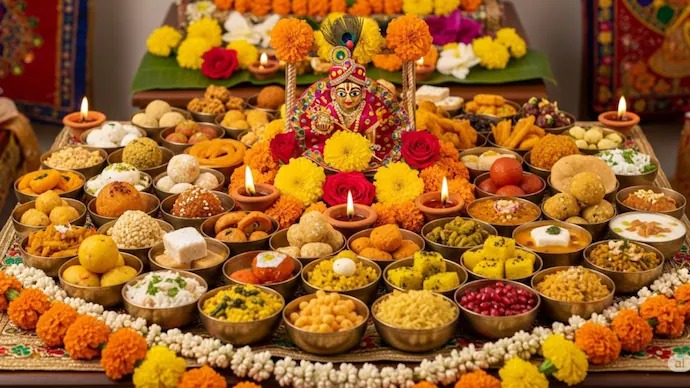
Follow WOWNEWS 24x7 on:

Key Highlights: Tradition and Taste in Every Offering
As devotees across India celebrate Krishna Janmashtami today, homes and temples become vibrant with the flavours of devotion. The festival not only commemorates the birth of Lord Krishna but also highlights how food rituals blend spiritual meaning and community joy. From the humble makhan mishri to the grand chhappan bhog, Janmashtami is truly where flavours meet faith.
Devotion Through Ritual Fasting and Sacred Cuisine
Janmashtami is traditionally marked by two types of fasting—nirjala (waterless) and phalahar (fruit and dairy)—with devotees abstaining until midnight, the divine birth hour. The evening culminates in a joyous breaking of fast with sacred food offerings.
Mindful choices like nuts, fresh fruits, and light satvic recipes help maintain energy and well-being through the day, while keeping traditions pure.
Chhappan Bhog: The Grandeur of 56 Dishes
One of Janmashtami’s most cherished customs is the chhappan bhog—a spectacular array of 56 delicacies offered to Krishna. This feast is believed to honour Krishna’s love for diverse tastes and abundance.
The platter includes everything from sweets and desserts (makhan mishri, peda, kheer, malpua, jalebi, laddus) to savouries (mathri, pakora, tikki, cheela), main courses (puri, rice, kadhi), and refreshing drinks (shikanji, almond milk). All dishes are made without onion and garlic, adhering to satvic principles.
Signature Dishes That Blend Faith and Flavour
Makhan Mishri: White butter and rock sugar served in clay pots, an ode to Krishna’s childhood mischief.
Panchamrit: A five-ingredient elixir—milk, curd, honey, ghee, and sugar—symbolizing purity and divinity; tulsi leaves and rose water add aroma and sanctity.
Dhaniya Panjiri: Roasted coriander seeds, dry fruits, ghee, and sugar—a nutritious and energizing prasad perfect for fasting days.
Makhana Paag: Fox nuts roasted and sweetened with jaggery, a crunchy tribute from Mathura and Vrindavan.
Sabudana Kheer: Tapioca pearls simmered in flavored milk, a vrat-friendly dessert for those observing the fast.
Dry Fruit Laddu: Energy-packed balls combining dates, figs, almonds, and cashews, ideal for health and festivity alike.
Chef’s Touch and Modern Twists
Celebrity chefs like Kunal Kapur share festive recipes such as dhaniya panjiri and elaborate panchamrit, blending age-old wisdom with culinary finesse.
Families try creative yet simple versions of traditional bhogs, ensuring everyone can join in, regardless of dietary restraints.
Sharing, Community, and Spiritual Connection
Janmashtami is not just about personal devotion but also about community bonding—sharing prasad, inviting neighbours, and participating in temple celebrations.
The midnight rituals, joyous singing, and offering of food bring together generations in a celebration of abundance, gratitude, and divine love.
Conclusion
Krishna Janmashtami, at its core, transforms kitchens into sanctuaries and everyday ingredients into expressions of faith. This sacred fusion of flavour and devotion not only honours tradition but also brings families and communities together for a nourishing, joyful celebration that lingers far beyond midnight.
Sources: Times of India, India TV, Free Press Journal, News18, Wipro Appliances, Zoff Foods




